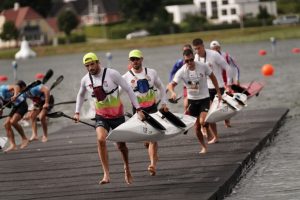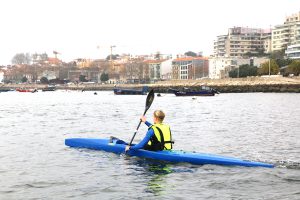There are many benefits to training with resistance, namely improving your Specific Strength, working on certain aspects of your paddling technique, and really appreciating how much glide you have when you take it off!
Resistance Training
Training with resistance can help take your paddling to the next level.
There are many benefits to training with resistance, namely improving your Specific Strength, working on certain aspects of your paddling technique, and really appreciating how much glide you have when you take it off!
There are 3 main types of resistance you can use, each with their own benefits:
Changing the smooth surface of your boat’s hull – by adding a Bungi Cord, with or without balls attached, or a thick pipe (like a garden hose), towing a parachute behind your boat, or adding WEIGHT to the boat.
1. CHANGING THE HULL SURFACE

BUNGI CORD
Adding resistance to your boat with decrease the amount of glide you have. This creates a need for a powerful and correct “catch” phase of your stroke, in order to get the boat to move.
The bungi will highlight any inefficiencies you have in your stroke, and is often a helpful diagnostic tool for coaches.
When using a bungi, be sure to still aim for good “distance per stroke”, with a powerful catch, good rotation, and a clean exit.
Goal: Increase strength endurance, reinforce positive technique
Watch out for: adding too much resistance that you battle to maintain good technique and have to change your stroke mechanics to cope with the resistance.
2. PARACHUTE
TOWING A PARACHUTE
I remember training with Tim Brabants in Cape Town one summer during our build up to Beijing. Watching him pull a parachute behind his K1 was inspirational, and he made it look easy. (He did go on to win 2 medals in China!)
The parachute creates massive drag, and will improve your maximal power development.
Make sure you build up to this type of resistance slowly, as it can cause injury if done incorrectly. Also be sure to use this method for power development, i.e. keep the sprints short.
Training with high resistance will result in a slower speed, and you do not want to create the wrong neuromuscular patterning. “Training slow equals racing slow”.
3. ADDING WEIGHT TO YOUR BOAT
Adding weight to your boat will make it harder to maintain the glide, and ultimately the speed of the boat.
This increase in weight will require more torque to maintain a good glide. To stay efficient, concentrate on a solid connection with the water, and using leg drive to transfer the power from your legs onto the blade.
Be sure to slowly increase the weight you add.
SUMMARY
Training with resistance is a fantastic technical tool to improve your paddling, and to increase your specific strength, power and strength endurance. As a bonus, you will be improving fitness at the same time.
Be sure to build up to the resistance, start out with a fairly light version of the type of resistance you are going to use, and then slowly start adding as you get stronger.
Remember to always maintain good stroke mechanics, this tool is meant to enhance your paddling not make you slower. Maintaining good distance per stroke, and glide, while using resistance, should be your focus point.





